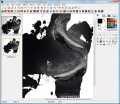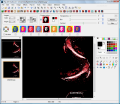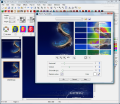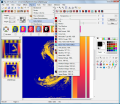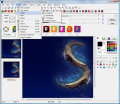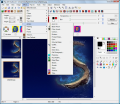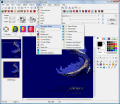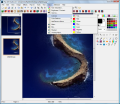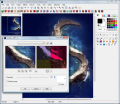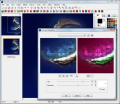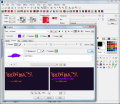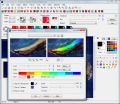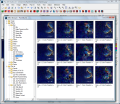Have you ever thought that editing an image could actually turn into a work of art? If not, you might find it interesting to discover that the one-click adjustments and transformations that you are now able to apply to an image have been first experienced as forms of art. It is not everyday that you encounter such connections between visual arts and software technology.
There is no easier way to get familiarized with certain artistic practices than by actually testing and reproducing their main features by yourself. Regarding that, Pop Art Studio is a helpful application that comes to guide and ease your creativity. It?s not about exploring a limited range of popular visual effects that emerged during the ?60s in the American pop art, but it?s about integrating these effects into a typical platform of image and graphic editing.
Whether you are familiar with the main characteristics of the art of Andy Warhol, Roy Lichtenstein or Robert Rauschenberg or not, you will find it captivating to explore them all by applying similar graphic effects to your own images. As many of you know, the silkscreen that Warhol massively used in post-producing famous brand images like Marilyn Monroe, Coca-Cola, Che Guevara or Mercedes has turned into a famous visual effect which is widely used in fashion or commercial industry today. Just a couple of days ago, I was really surprised to accidentally notice in a fashion magazine a set of coffee-cups with Andy Warhol?s ?Marilyns? printed on. You'll see how very easy Pop Art Studio can make this for you. All you have to do is simply import your image file. If it wasn?t for the name and the additional features that make the software topic specific, you could really consider it a valid alternative to all the image editing applications. In fact, Pop Art Studio is even more than a simple editing program, as it provides a bonus feature which regards not necessarily hi-tech visual effects, filters or adjustments for your images, but also a practical art history tutorial that widens your knowledge and guides you through the basics of contemporary art. In most cases, the Help topics of an application refer strictly to the technical details of ?how to? use the program?s components; but with Pop Art Studio, things go beyond this first stage and you are guided not only to correctly apply certain adjustments, but also to understand different theoretical frameworks regarding pop art and its key figures.
The interface of Pop Art Studio comes with a complete set of instruments and options which might be familiar to you, as in most part they are common image editing tools: geometrical transformations like resize, crop, flip, skew or rotate, image adjustments such as color balance, gamma correction, brightness and contrast, hue and saturation and so on. Among these, you can also find vectorial graphic instruments that allow you to manage shape and text elements.
What is a bit questionable in working with vectorials in Pop Art Studio is that there is no new layer added when creating a shape or a text and working without layers is not quite to be preferred. I guess layers are such an enigma for Pop Art Studio, as this word doesn?t even exist in the help index. You'll have to consider working with vectorials for some other applications. Still, considering the main purpose of this software, lacking layers is not that disturbing after all. Usually, you import an existing image, be it GIF, BMP, TIFF or PNG, you modify it by adding a series of effects and after that you save it.
The left panel of the working sheet is very useful as it instantly allows visualization with thumbnails of all the images you are working with at the same time. On the right side there are the main tools and, the most important, the object properties panel which permits you to change and edit the properties of the selected objects.
Besides the main pop art-like effects, Pop Art Studio is even more accessible to people who haven?t heard yet about pop art or at least about Andy Warhol. Therefore, you can still apply some popular effects of artists that everyone easily recognizes such as Leonardo daVinci, van Gogh, the impressionists, Mondrian or Klee.
One useful fact is that you can add images to be edited just by dragging them up from your desktop or any file manager that you are using. This makes the program handful in relation to your other applications and completes its friendly usability. You will notice that the application doesn't require too much of your physical memory and CPU usage, but that's already obvious from the moment you open Pop Art Studio, as it loads very quickly.
Another key element of pop art was the serialism and Pop Art Studio "is aware" of this, too. Mostly, on Andy Warhol-like effects, you can chose a specific number of copies for your image and then select the color schemes that you prefer, as each copy of your image comes with a new color scheme. And that makes it so easy for you to organize your final composition which will only need to be finally printed!
The Good
What?s really exciting about Pop Art Studio is definitely its very small size on disk. This makes it quite efficient and thrifty, as you may consider it more convenient to use for common image adjustments, which you could normally apply using complex image editing applications like Photoshop. And this turns Pop Art Studio into precisely what many people would demand for their basic needs in processing a digital image: smaller size on disk and smaller hardware requirements combined with a maximum range of flexible features.
The Bad
One inconvenience that comes in managing the versatile interface that Pop Art Studio tends to provide is the unhandy zoom toolbar and also the lack of alternative zoom options with which you might be already used to from other image editing applications that you have worked with before (a mouse scrolling zoom in and out, or at least the very common ?+? and ?-? shortcut keys that adjust the size of the image according to your preferences).
The Truth
The registration screen that appears when you start the application might seam a bit bothering at first, but I bet that once you run Pop Art Studio you won?t be that eager to turn it off too soon, as it will definitely catch your curiosity and interest. And yet, it?s a good reason to convince you to buy the software, as I guess you?ll want to save the edited version of the image you?ve worked with.
In fact, having to face a disabled saving option is quite frustrating and one might rather prefer something like a watermark for example to be randomly attached to the image.
Here are some snapshots of the application in action:
 14 DAY TRIAL //
14 DAY TRIAL // 